

Hannah Senesh's Notebook: Solving the Mystery of the Missing Pages
In the early 1950s, Katherine Senesh, the mother of the famous paratrooper and poet Hannah Senesh (often spelled Szenes), entrusted a number of documents from her daughter’s estate to the National Library of Israel. Among these were some of her letters, a collection of typed poems she had written in Hungarian, as well as four handwritten poems in Hebrew.
The four handwritten poems were written during 1941 in various places linked to Senesh’s life: two of them in Nahalal, one in Kibbutz Ginosar and one in Kibbutz Sdot Yam, of which she was a founding member.
The upper corners of the handwritten pages are numbered, and the pages look as though they have been torn from a notebook, which they were. Yet the complete story of these pages only came to light seven decades later, in the year 2020. Now we can tell it.
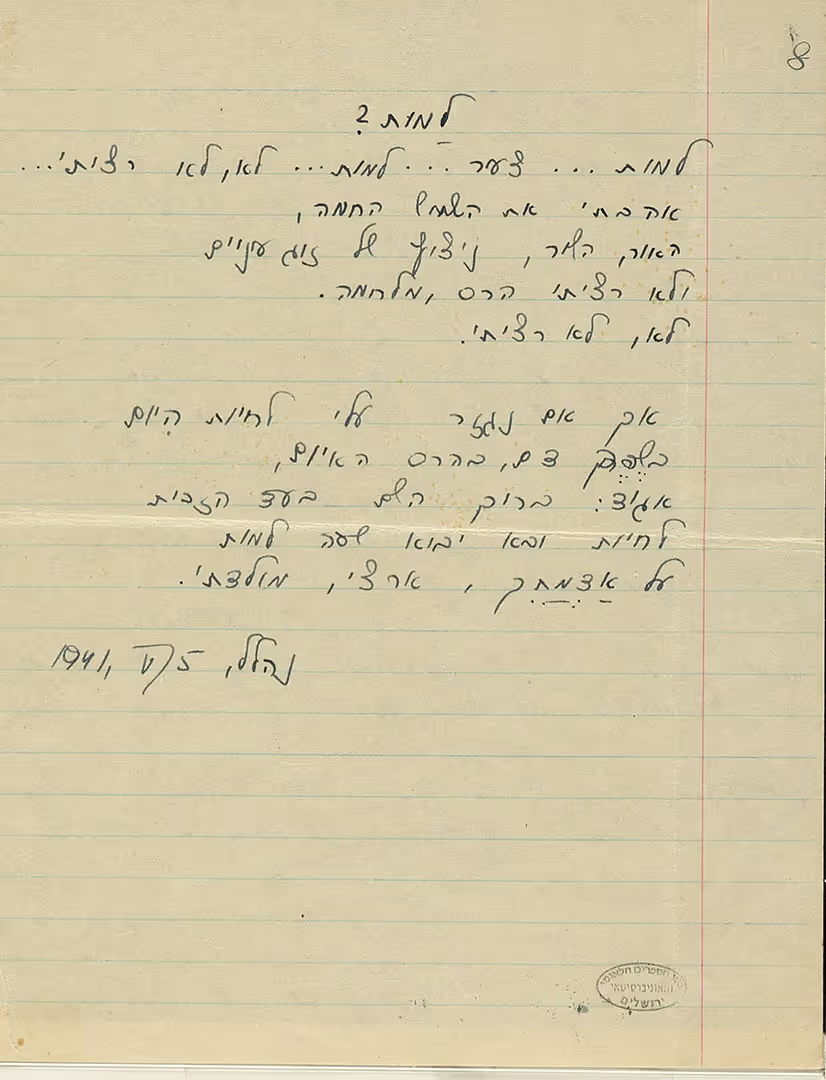
In the early 1950s, Katherine Senesh, the mother of the famous paratrooper and poet Hannah Senesh (often spelled Szenes), entrusted a number of documents from her daughter’s estate to the National Library of Israel. Among these were some of her letters, a collection of typed poems she had written in Hungarian, as well as four handwritten poems in Hebrew.
The four handwritten poems were written during 1941 in various places linked to Senesh’s life: two of them in Nahalal, one in Kibbutz Ginosar and one in Kibbutz Sdot Yam, of which she was a founding member.
The upper corners of the handwritten pages are numbered, and the pages look as though they have been torn from a notebook, which they were. Yet the complete story of these pages only came to light seven decades later, in the year 2020. Now we can tell it.



In the early 1950s, Katherine Senesh, the mother of the famous paratrooper and poet Hannah Senesh (often spelled Szenes), entrusted a number of documents from her daughter’s estate to the National Library of Israel. Among these were some of her letters, a collection of typed poems she had written in Hungarian, as well as four handwritten poems in Hebrew.
The four handwritten poems were written during 1941 in various places linked to Senesh’s life: two of them in Nahalal, one in Kibbutz Ginosar and one in Kibbutz Sdot Yam, of which she was a founding member.
The upper corners of the handwritten pages are numbered, and the pages look as though they have been torn from a notebook, which they were. Yet the complete story of these pages only came to light seven decades later, in the year 2020. Now we can tell it.

Hannah Senseh was always writing. She was born into a home where writing was an integral part of family life, and she herself began to do so at a very young age. She wrote first in her mother tongue, Hungarian. After arriving in the Land of Israel, she began to learn Hebrew and very quickly mastered writing in that language as well. She wrote constantly and kept a diary for years. She wrote her poems in secret, with all of them being published posthumously.
In 1944, just before embarking on the parachute mission from which she did not return, Senesh copied her poems neatly into a notebook with numbered pages. She titled the notebook Lelo Safa (“Without Language”) though most of the poems were in Hebrew, and signed it with her underground codename, Hagar. She gave this notebook to her close friend and classmate at the Nahalal Agricultural School for Girls, Miriam Yitzhak. On the first page, she added a dedication: “To Miriam Yitzhak, my first and dearest reader and critic, in true friendship, Hannah.”

Hannah Senseh was always writing. She was born into a home where writing was an integral part of family life, and she herself began to do so at a very young age. She wrote first in her mother tongue, Hungarian. After arriving in the Land of Israel, she began to learn Hebrew and very quickly mastered writing in that language as well. She wrote constantly and kept a diary for years. She wrote her poems in secret, with all of them being published posthumously.
In 1944, just before embarking on the parachute mission from which she did not return, Senesh copied her poems neatly into a notebook with numbered pages. She titled the notebook Lelo Safa (“Without Language”) though most of the poems were in Hebrew, and signed it with her underground codename, Hagar. She gave this notebook to her close friend and classmate at the Nahalal Agricultural School for Girls, Miriam Yitzhak. On the first page, she added a dedication: “To Miriam Yitzhak, my first and dearest reader and critic, in true friendship, Hannah.”

Hannah Senseh was always writing. She was born into a home where writing was an integral part of family life, and she herself began to do so at a very young age. She wrote first in her mother tongue, Hungarian. After arriving in the Land of Israel, she began to learn Hebrew and very quickly mastered writing in that language as well. She wrote constantly and kept a diary for years. She wrote her poems in secret, with all of them being published posthumously.
In 1944, just before embarking on the parachute mission from which she did not return, Senesh copied her poems neatly into a notebook with numbered pages. She titled the notebook Lelo Safa (“Without Language”) though most of the poems were in Hebrew, and signed it with her underground codename, Hagar. She gave this notebook to her close friend and classmate at the Nahalal Agricultural School for Girls, Miriam Yitzhak. On the first page, she added a dedication: “To Miriam Yitzhak, my first and dearest reader and critic, in true friendship, Hannah.”



When Katherine Senesh arrived in Israel and began collecting poems and letters for the commemoration of her daughter, she asked Miriam, who had kept the treasured notebook, to send her some poems in Hannah’s handwriting. In a letter Katherine wrote to collector Abraham Schwadron, who founded the National Library's collection of autographs and portraits, she mentioned Miriam’s qualms about tearing pages from the notebook: “This time I am sending the poems I promised, the ones that Hannah’s friend, after much hesitation, was willing to tear from the notebook.” This was how the pages reached the archives of the National Library of Israel.
It was only decades later that the torn pages were finally reunited with the complete notebook.
After Miriam Yitzhak’s death, the notebook passed into the possession of Eitan Senesh, Hannah’s nephew, who for years managed, cataloged and maintained the Hannah Senesh collection. In November 2020, when the family decided to deposit the entire Hannah Senesh Collection with the National Library, Eitan confessed that he asked himself many times what had happened to those missing pages – numbered 7, 8, 11 and 12 in Hannah’s handwriting. Eitan did not know that his grandmother, Katherine, had already handed them over to the National Library seventy years earlier, into Abraham Schwadron’s trustworthy hands.
This was how the lost pages were finally reunited with the original notebook, from which they were torn. Along with the notebook, the deposit included a vast archive of certificates, documents from Hungary, manuscripts, letters, photographs and dozens of other personal items, among them Hannah's typewriter as well as her camera.

When Katherine Senesh arrived in Israel and began collecting poems and letters for the commemoration of her daughter, she asked Miriam, who had kept the treasured notebook, to send her some poems in Hannah’s handwriting. In a letter Katherine wrote to collector Abraham Schwadron, who founded the National Library's collection of autographs and portraits, she mentioned Miriam’s qualms about tearing pages from the notebook: “This time I am sending the poems I promised, the ones that Hannah’s friend, after much hesitation, was willing to tear from the notebook.” This was how the pages reached the archives of the National Library of Israel.
It was only decades later that the torn pages were finally reunited with the complete notebook.
After Miriam Yitzhak’s death, the notebook passed into the possession of Eitan Senesh, Hannah’s nephew, who for years managed, cataloged and maintained the Hannah Senesh collection. In November 2020, when the family decided to deposit the entire Hannah Senesh Collection with the National Library, Eitan confessed that he asked himself many times what had happened to those missing pages – numbered 7, 8, 11 and 12 in Hannah’s handwriting. Eitan did not know that his grandmother, Katherine, had already handed them over to the National Library seventy years earlier, into Abraham Schwadron’s trustworthy hands.
This was how the lost pages were finally reunited with the original notebook, from which they were torn. Along with the notebook, the deposit included a vast archive of certificates, documents from Hungary, manuscripts, letters, photographs and dozens of other personal items, among them Hannah's typewriter as well as her camera.



When Katherine Senesh arrived in Israel and began collecting poems and letters for the commemoration of her daughter, she asked Miriam, who had kept the treasured notebook, to send her some poems in Hannah’s handwriting. In a letter Katherine wrote to collector Abraham Schwadron, who founded the National Library's collection of autographs and portraits, she mentioned Miriam’s qualms about tearing pages from the notebook: “This time I am sending the poems I promised, the ones that Hannah’s friend, after much hesitation, was willing to tear from the notebook.” This was how the pages reached the archives of the National Library of Israel.
It was only decades later that the torn pages were finally reunited with the complete notebook.
After Miriam Yitzhak’s death, the notebook passed into the possession of Eitan Senesh, Hannah’s nephew, who for years managed, cataloged and maintained the Hannah Senesh collection. In November 2020, when the family decided to deposit the entire Hannah Senesh Collection with the National Library, Eitan confessed that he asked himself many times what had happened to those missing pages – numbered 7, 8, 11 and 12 in Hannah’s handwriting. Eitan did not know that his grandmother, Katherine, had already handed them over to the National Library seventy years earlier, into Abraham Schwadron’s trustworthy hands.
This was how the lost pages were finally reunited with the original notebook, from which they were torn. Along with the notebook, the deposit included a vast archive of certificates, documents from Hungary, manuscripts, letters, photographs and dozens of other personal items, among them Hannah's typewriter as well as her camera.

tab1img2=The handwritten text of Hannah Senesh’s Hebrew poem Lamut? (“To Die?”), donated to the National Library by her mother. From the Schwadron Collection at the National Library of Israel, the Senesh Family Archive, with thanks to Ori and Mirit Eisen
tab2img1=“To Miriam Yitzhak, my first and dearest reader and critic, in true friendship, Hannah.” Hannah Senesh’s handwritten Hebrew dedication to her friend, Miriam Yitzhak, from the Senesh Family Archive, with thanks to Ori and Mirit Eisen
tab3img2=Two poems from Hannah Senesh’s handwritten notebook. The page on the right is numbered “10”, and the one on the left is numbered “13”. Pages 11 and 12 are among those torn out in the 1950s and donated to the National Library. From the Senesh Family Archive, with thanks to Ori and Mirit Eisen




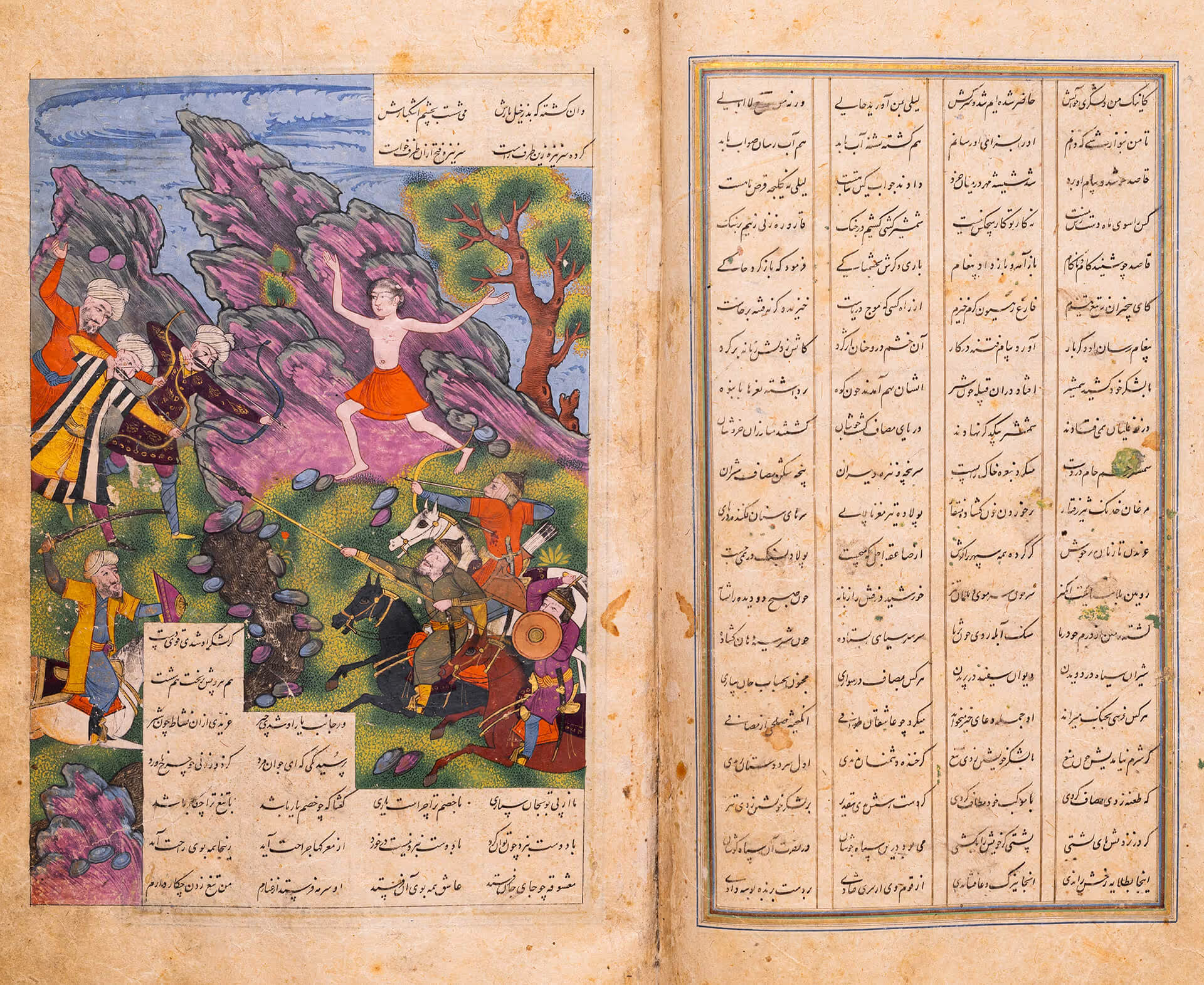
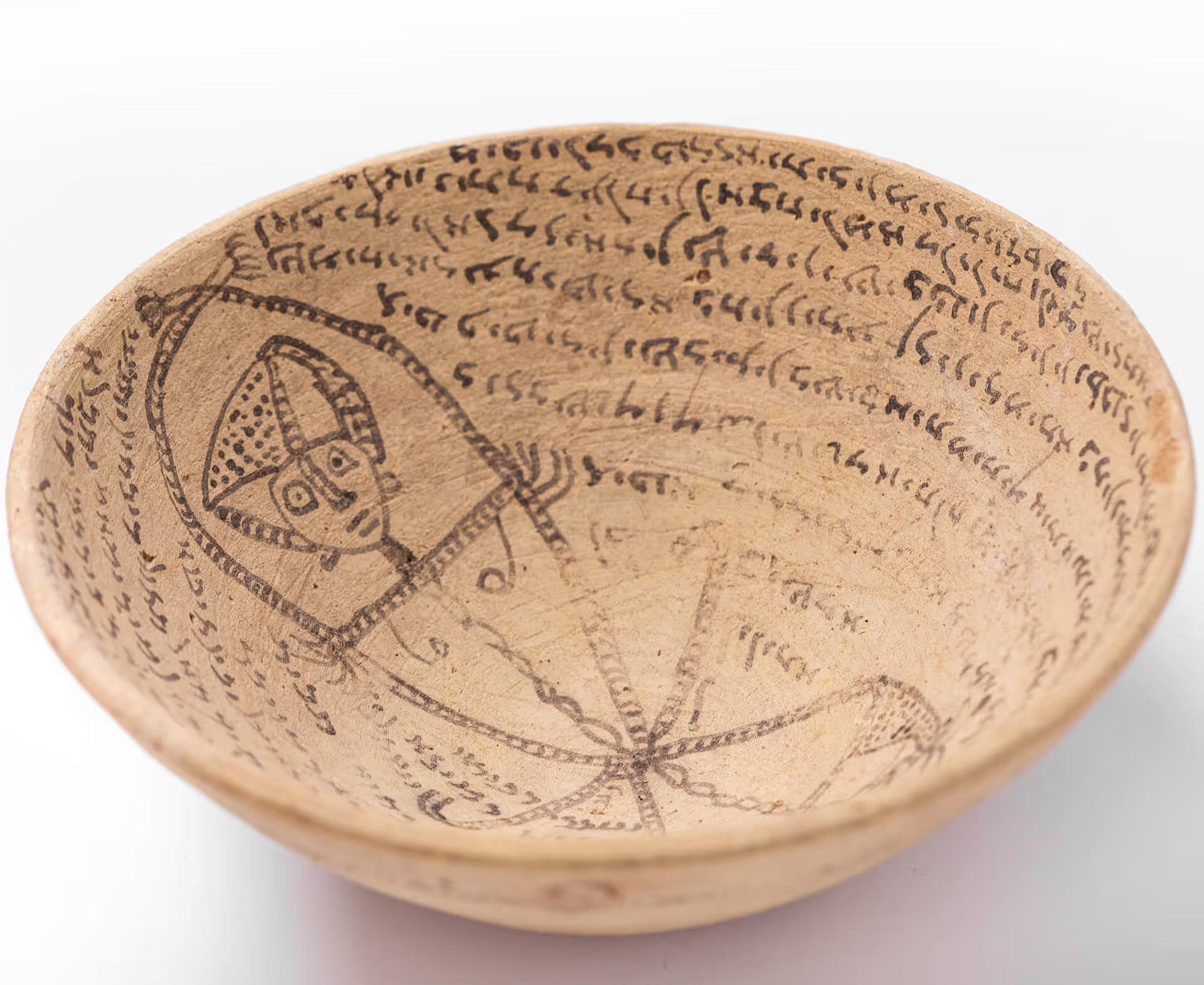
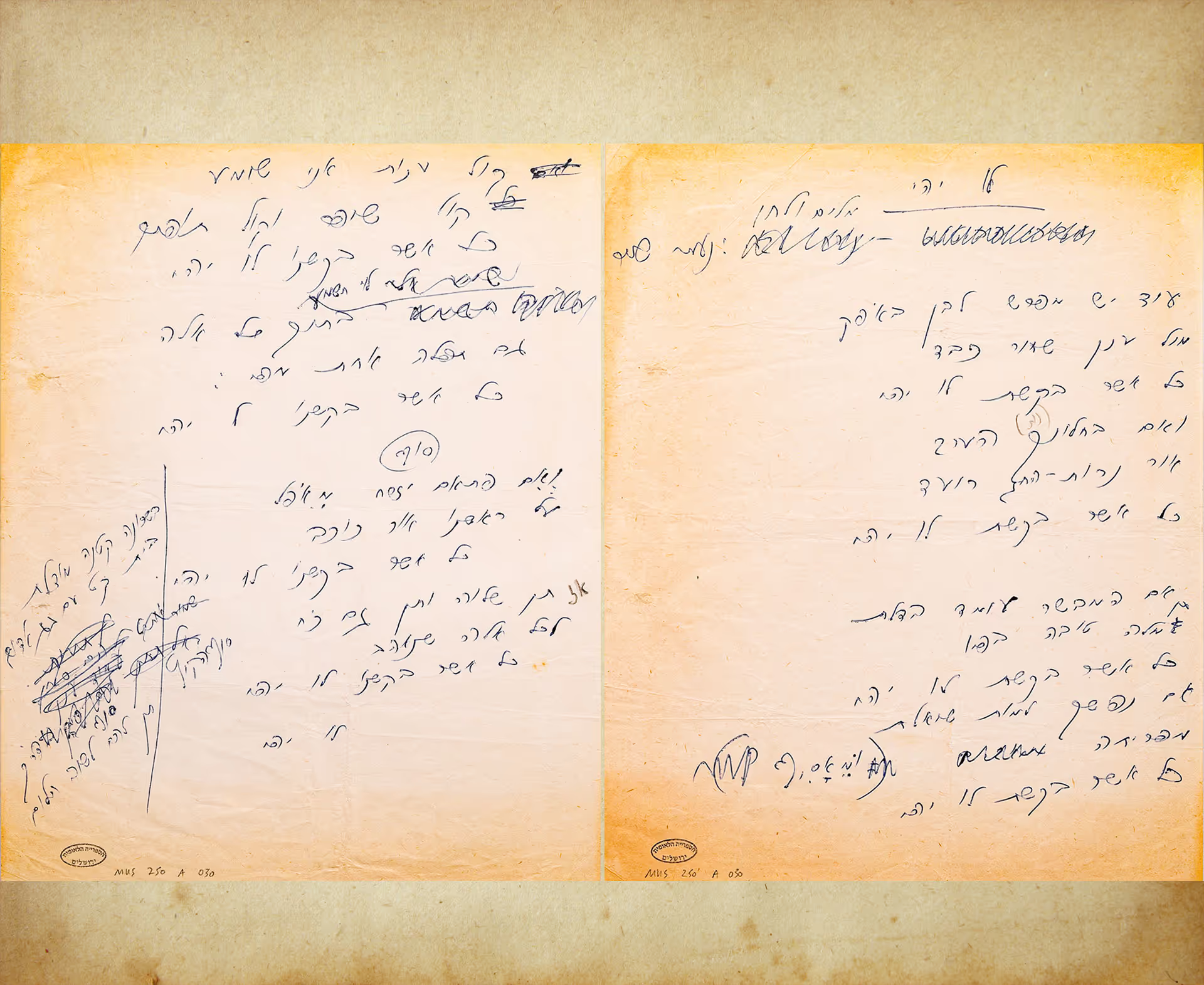
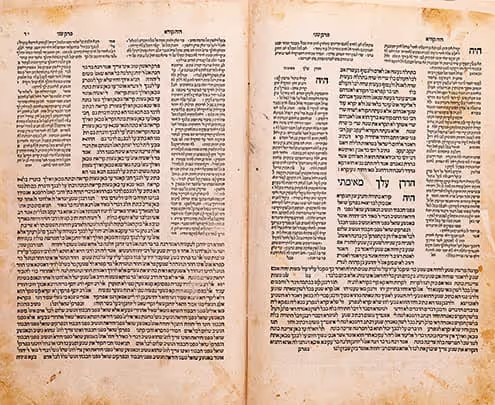





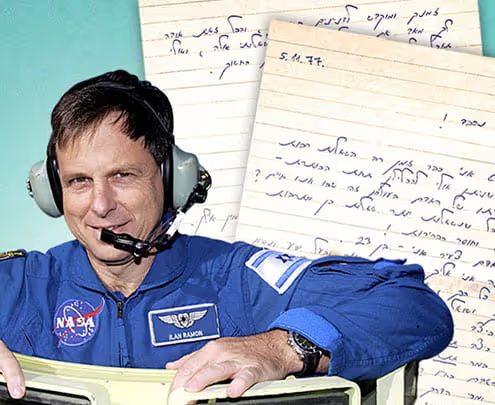

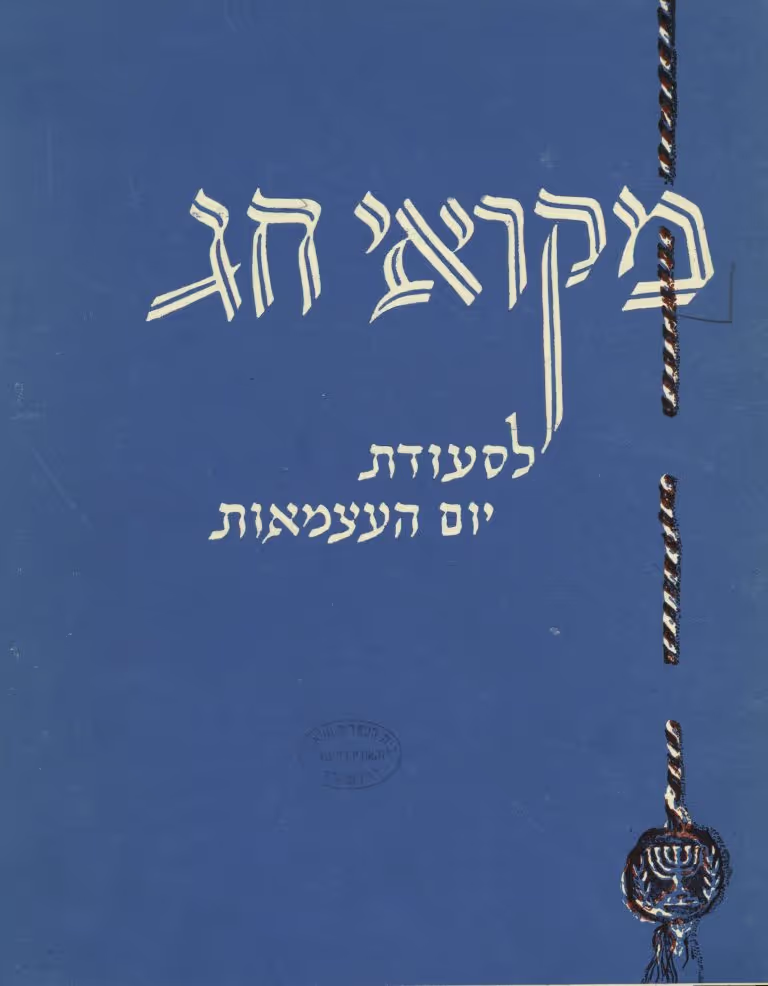
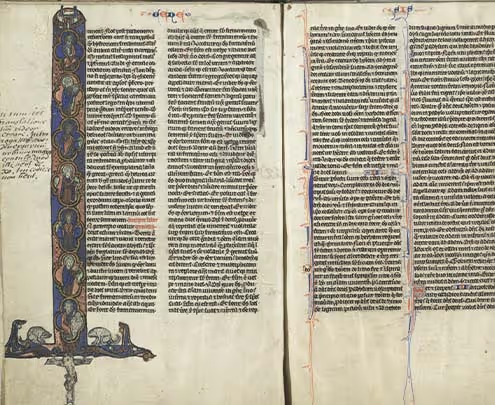

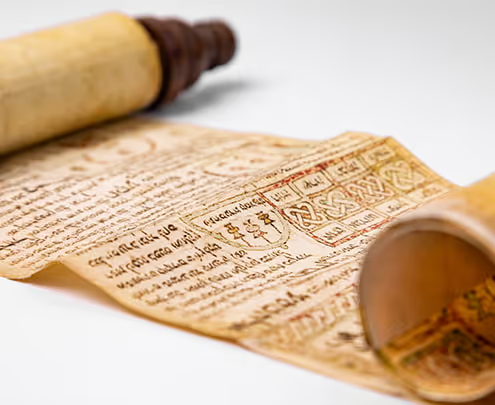

.avif)
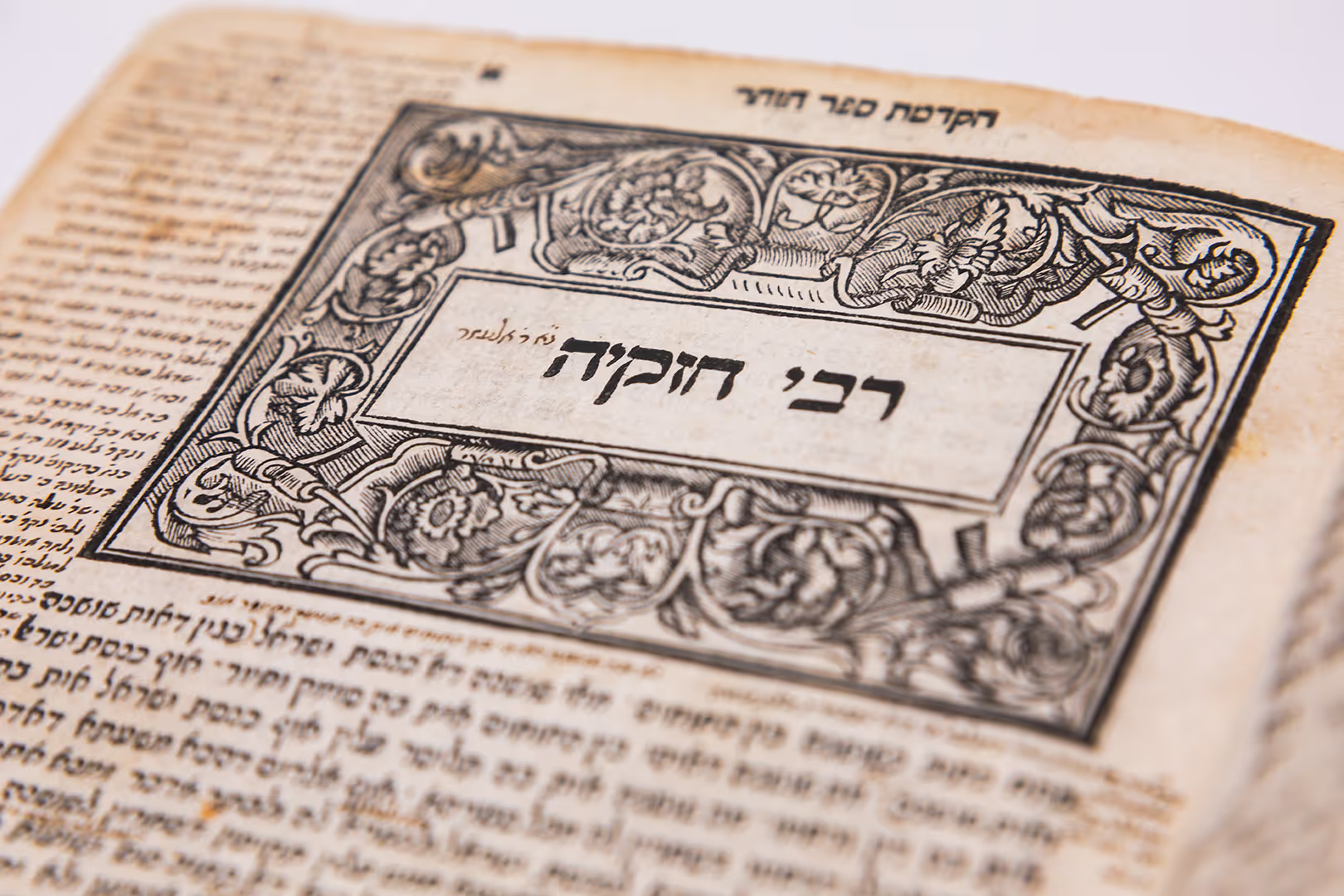





.svg)





